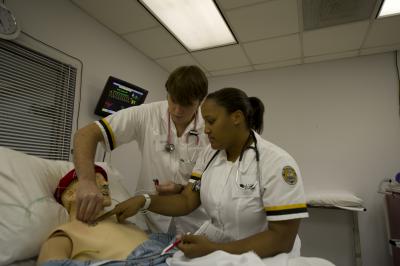Simulation Study Helps Prepare Southern Miss Nursing Students
Tue, 05/15/2012 - 01:16pm | By: Van Arnold

For University of Southern Mississippi nursing student Kara Scott, simulation exercises provide the next-best-thing to actual patient care.
“As students we don't get to do things like call physicians or administer IV push medications,” said Scott, a junior from Slidell, La. “But with the simulation training, we get to experience those kinds of scenarios. It allows us to be involved in decision making and delegating different procedures.”
Scott and 82 other School of Nursing classmates are participating in a national study funded by the National Council of State Boards of Nursing (NCSBN) to examine the use of simulation in nursing education. The two-year study, which includes a $300,000 grant, began with the 2011 fall semester.
Dr. Kathleen Masters, associate professor and associate director of the Southern Miss School of Nursing, serves as the project's team leader. In that role, Masters is primarily responsible for scheduling, data collection and working with clinical faculty to match the simulation scenarios with the course curriculum.
Other team members from the School of Nursing include Dr. Cathy Hughes, Dr. Elizabeth Holman, Becky Newton and Jill Rushing. This group oversees the simulation scenarios and conducts debriefing sessions with students.
Masters stresses that simulation experiences are not meant to replace the experiences that nursing students need providing care to real patients in the traditional clinical setting. However, by using simulation experiences to augment clinical experiences throughout the curriculum, the faculty is able to ensure that every student has experience with patient problems that may be rare but critical as well as patient problems that are common but that not every student has the opportunity to see in a particular clinical setting.
“In the simulation environment, the student can be the nurse responsible for calling the physician, transfusing blood products and collaborating with other members of the health care team,” said Masters. “Simulation provides a safe learning environment where the student must act like a nurse, rather than a nursing student and therefore the nursing student begins to think like a nurse.”
Masters notes that students receive “patient” information prior to their rotations in simulation so that they can prepare for the simulation experience just as they would prepare for a patient experience in the traditional clinical setting. During a day in the simulation lab, students typically care for four different patients with debriefing sessions between each simulated patient encounter.
Sophisticated, life-size mannequins serve as the “patients” while fellow team members often portray family members.
“Playing the role of a family member is extremely helpful because their presence is just as important as the patient's many times,” said Chris Robinson, a senior nursing student from Madison, Miss. “There can be situations where family members are very upset and asking many different questions. As nurses, you have to know how to react in those situations and this kind of simulation is extremely helpful in that regard.”
Other sites chosen for the NCSBN Simulation Study include: College of Southern Nevada; Florida International University; Ivy Tech Community College of Indiana; Johns Hopkins University; Johnson County (Kansas) Community College; Lancaster (Pennsylvania) General College of Nursing and Health Sciences; Metropolitan Community College-Penn Valley (Missouri); University of South Carolina and Washington State University.
The sites' study teams will monitor students daily, upon completion of each clinical course, after one year in the nursing program, upon graduation and, finally, one year postgraduation. Masters and her team provide weekly reports to the NCSBN Simulation Study Principle Investigator.
“At the end of each semester the grade point average and ATI test scores are also reported to NCSBN for all students enrolled in the study,” said Masters. “Since this is the end of year one of the study, blinded evaluators have been trained to evaluate study participants' performance during simulation. Each student in the study has been evaluated once during the semester by a blinded evaluator. These results are also sent to NCSBN.”
For nursing student Rebecca Fleuriet, a junior from New Orleans, the simulation study has yielded much more than realistic training for patient services.
“We're all like a family in here,” she said. “We've studied together, learned together and cried together. This has been a wonderful experience for me and I know it's going to help me become a better nurse someday.”
For more information about the School of Nursing at Southern Miss, call 601.266.5454 or visit: http://www.usm.edu/nursing

